Notable players to have worn #12 include Wayne Cashman, Gary Dornhoefer, Simon Gagne, Bill Guerin, Tim Kerr, Tom Lysiak, Don Maloney, Patrick Marleau, Adam Oates, Pat Stapleton, Ron Stewart and Johnny Upton.
One active player we anticipate will have his number retired is the Calgary Flames Jarome Iginla, who has played every one of his 16 NHL seasons with the Flames. Iginla was the Art Ross Trophy winner in 2002 as the NHL's leading scorer and is a member of the 500 goal club, having won the Rocket Richard Trophy as the league's leading goal scorer twice, in 2002 (52) and 2004 (41) as well as another 50 goal season in 2008. He also was named the winner of the Lester Pearson Award in 2002, given to the most outstanding player as voted by the players association. Iginla has been the Flames captain since the 2003-04 season and has also won the King Clancy Trophy for leadership qualities on and off the ice and making a significant contribution to his community.
Iginla's featured jersey is a 1998-99 Calgary Flames Jarome Iginla jersey as worn in Tokyo, Japan during the Flames game on October 10, 1998 against the San Jose Sharks, commemorated with the Game ONe 98 Japan patch on the upper right chest. This game was the debut of the Flames new black alternate jerseys with the horse head logo, worn in recognition of the famous Calgary Stampede rodeo.
One of our favorite features of the jersey is the use of the old Atlanta Flames logo as the alternate captain's "A", in recognition of the franchise's origins in Atlanta.
While we are confident the Flames will retire Iginla's number #12 someday, we wonder why the Washington Capitals have yet to retire Peter Bondra's #12?
Bondra is the Capitals franchise leader in goals with 472, ranks sixth in assists with 353 and remains their all-time leading scorer with 825 points. He also still holds nine team scoring records, including power play, shorthanded and game-winning goals in both a single season as well as in a career.
He played for the Capitals for 14 seasons, third most in franchise history, and led them in scoring for five of those seasons. His goals, points and years of service are greater than all four of the players who have had their jerseys retired by the Capitals, and honoring him is now overdue, something which needs to be corrected.
Bondra's featured jersey is a 1998-99 Washington Capitals Peter Bondra jersey. The Capitals comprehensively rebranded themselves in 1995 when they introduced an entirely new color scheme and logo, replacing their original red, white and blue colors with blue, bronze and black. Two seasons later they debuted a new third jersey, which promoted their secondary logo to the front of their new black jersey. Note the arched treatment for the name on the back, which also employed a single white outline to encapsulate the entire name.
1999-00 was the final season of use as an alternate, notable for the NHL 2000 patch worn by all the players that season. For the 2000-01 season, this jersey replaced The Capitals blue road jersey with the black jersey, which saw the names on the back become straight across and each letter now separate from the others.
While with the Canucks he would become the franchise's leading goal scorer while scoring 60 or more points for seven straight seasons and 20 or more goals for eight straight. He captained the Canucks for eight seasons and would close out his career as the Canucks leader in goals (262), assists (411), points (673) and games (896). While his offensive numbers would decrease dramatically near the end of his career, he was still a valuable player thanks to his defensive skills and relentless checking as well as his leadership.
Abel won the Hart Trophy as MVP of the NHL in 1949 and finished his career with 189 goals and 472 points in 612 games. He later coached the Red Wings from 1957 through 1968 and was elected into the Hockey Hall of Fame in 1969.
Today's featured Abel jersey is a 1949-50 Detroit Red Wings Sid Abel jersey from Abel's second Stanley Cup winning season. Note the lack of sleeve numbers on this old sweater, which did not arrive until 1961.
This design originated in 1932 when the Detroit Falcons changed their name to the Red Wings and has remained essentially unchanged ever since.
After not retiring any jerseys for ten years, as part of their Centennial celebrations, the Canadiens announced a series of sweater retirements to take place over the course of five seasons. Having retired just one number in 20 years, the Canadiens began to make up for lost time by unusually retiring the #12 for two men, Dickie Moore and Yvan Cournoyer during the same ceremony on November 12, 2005.
Moore was a two-time Art Ross Trophy winner who once held the NHL single season scoring record with 96 points. In 12 years with the Canadiens, Moore won six Stanley Cups, including five consecutive, and he was inducted into the Hockey Hall of Fame in 1974.
Our final featured #12 jersey is a 1974-75 Montreal Canadiens Yvan Cournoyer jersey. This was the final season in which the Canadiens wore a tie-neck collar and yet to add names on the backs of their sweaters. This exact variation of the Canadiens sweater arrived in 1963 and remained in use through 1975, although the basic design can be traced back to 1912, five years before the formation of the NHL. Note the back numbers are not centered on the blue stripe. While the placement of the numbers on the stripe has varied over the years, some higher and some lower, the numbers seldom, if ever, have been centered on the stripe as many assume.

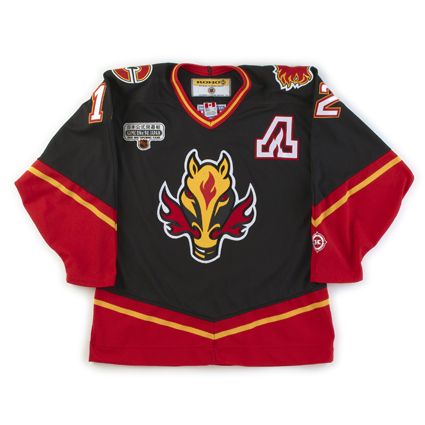
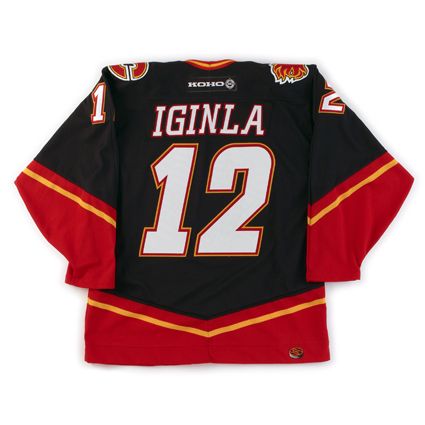


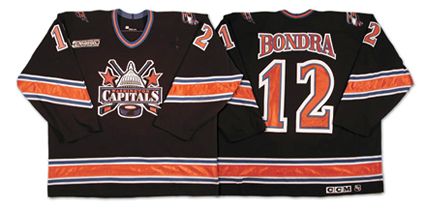
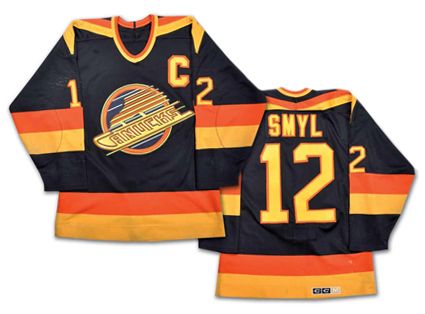
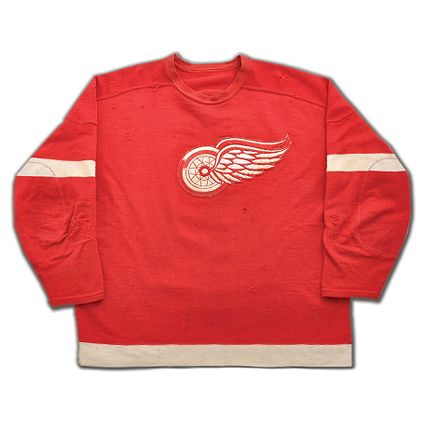
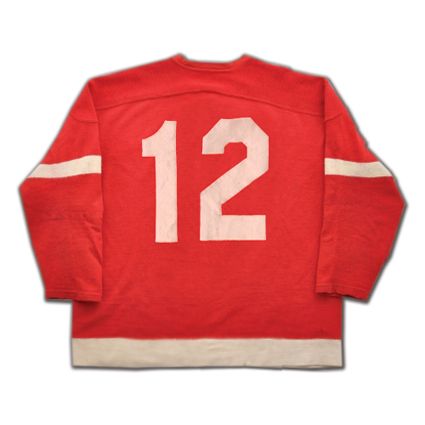
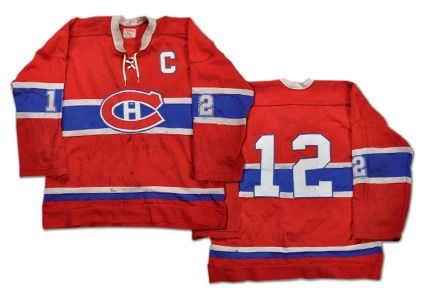










No comments:
Post a Comment
We welcome and encourage genuine comments and corrections from our readers. Please no spam. It will not be approved and never seen.